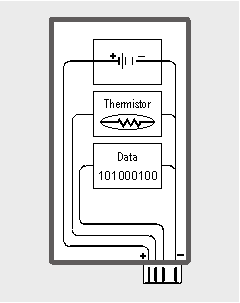<< Previous page INDEX Next page >>
7. The ‘Smart’ Battery
Aspeaker at a battery seminar remarked that, “The battery is a wild animal and artificial intelligence domesticates it.” An ordinary or ‘dumb’ battery has the inherit problem of not being able to display the amount of reserve energy it holds. Neither weight, color, nor size provides any indication of the battery’s state-of-charge (SoC) and state-of-health (SoH). The user is at the mercy of the battery when pulling a freshly charged battery from the charger.
Help is at hand. An increasing number of today’s rechargeable batteries are made ‘smart’. Equipped with a microchip, these batteries are able to communicate with the charger and user alike to provide statistical information. Typical applications for ‘smart’ batteries are notebook computers and video cameras. Increasingly, these batteries are also used in advanced biomedical devices and defense applications.
There are several types of ‘smart’ batteries, each offering different complexities, performance and cost. The most basic ‘smart’ battery may only contain a chip to identify its chemistry and tell the charger which charge algorithm to apply. Other batteries claim to be smart simply because they provide protection from overcharging, under-discharging and short-circuiting. In the eyes of the Smart Battery System (SBS) forum, these batteries cannot be called ‘smart’.
What then makes a battery ‘smart’? Definitions still vary among organizations and manufacturers. The SBS forum states that a ‘smart’ battery must be able to provide SoC indications. Benchmarq was the first company to commercialize the concept of the battery fuel gauge technology. Early IC chips date back to 1990. Several manufacturers followed suit and produced ‘smart’ chips for batteries.
During the early nineties, numerous ‘smart’ battery architectures with a SoC read-out have emerged. They range from the single wire system, the two-wire system and the system management bus (SMBus). Most two-wire systems are based on the SMBus protocol. This book will address the single wire system and the SMBus.
7.1 The Single Wire Bus
The single wire system is the simpler of the two and does all the data communications through one wire. A battery equipped with the single wire system uses only three wires, the positive and negative battery terminals and the data terminal. For safety reasons, most battery manufacturers run a separate wire for temperature sensing. Figure 7-1 shows the layout of a single wire system.
The modern single wire system stores battery-specific data and tracks battery parameters, including temperature, voltage, current and remaining charge. Because of simplicity and relatively low hardware cost, the single wire enjoys a broad market acceptance for high-end mobile phones, two-way radios and camcorders.
Most single wire systems do not have a common form factor; neither do they lend themselves to standardized SoH measurements. This produces problems for a universal charger concept. The Benchmarq single wire solution, for example, cannot measure current directly; it must be extracted from a change in capacity over time.
In addition, the single wire bus allows battery SoH measurement only when the host is ‘married’ to a designated battery pack. Such a fixed host-battery relationship is feasible with notebook computers, mobile phones or video cameras, provided the appropriate OEM battery is used. Any discrepancy in the battery type from the original will make the system unreliable or will provide false readings.
Figure 7-1: Single wire system of a ‘smart’ battery.
Only one wire is needed for data communications. Rather than supplying the clock signal from the outside, the battery includes an embedded clock generator. For safety reasons, most battery manufacturers run a separate wire for temperature sensing.
